Don M. Winn's Blog, page 19
July 14, 2016
Getting Lost in the Moment

Do you remember the last time you were lost in the moment? Getting lost in the moment can be described as being so immersed in something, usually something enjoyable, that you completely lose track of all time. Distractions ebb away, as do all other concerns. Everything else in your life is put tacitly on hold. If you’re an adult, especially a middle-aged-or-more adult, chances are those lost-in-time moments are few and far between. I have to admit that most of my memories of being lost in the moment are from childhood. What I remember most from those years is how much I loved art. I remember the total happy absorption I would feel as I immersed myself in my crayon drawings, completely unaware of the passage of time. Life was good.
But as we grow up, we have more and more on our mind. It gets much harder to be able to step away from worries, concerns, and frustrations, and once again address a current activity with total, undivided focus. Losing ourselves in the moment may even begin to feel like a selfish indulgence, since we have so many responsibilities. Interestingly, according to an article published by Harvard University psychologists Matthew Killingsworth and Daniel Gilbert back in 2011, this can be a significant source of unhappiness.

The broad conclusion of this study is that the more absorbed we are able to become in whatever our current activity might be, the happier we are. When our mind and thereby our attention wanders away from whatever we are doing, we become unhappy.
Killingsworth is quoted as saying, “Mind-wandering is an excellent predictor of people’s happiness. In fact, how often our minds leave the present and where they tend to go is a better predictor of our happiness than the activities in which we are engaged.”
Children have an amazing ability to lose themselves in the present moment, to give their entire attention to whatever they are doing without worrying or thinking about other aspects of their life, and as adults, we could benefit from their example. I’m not saying that all children do this all the time, but they certainly have the ability to do it.
You’ve likely seen your son or daughter caught up in building something or drawing something or inventing something. Maybe their brow is furrowed with concentration. Perhaps they are holding their mouth in that certain way they do, a tiny tip of their tongue peeking out. Or they are in the yard, running joyfully after a firefly or a butterfly, shrieking with delight.
If you have kids, take advantage of their example in this regard. Take some time to get down on the floor and play with them, read with them, talk with them (interestingly, the study found that one of the activities that made people happiest was having conversations)…lose yourself in the moment with them…even if it’s just for a moment. Of course your kids will enjoy it too!


June 30, 2016
Purposeful Parenting Month: Building a Positive Self-Image in Kids

One of the biggest challenges for parents today is helping their children cultivate a positive attitude about how they look and who they are as individuals—to appreciate their own unique beauty, inside and out, and not to feel like they have to look or act a certain way in order to be considered attractive or acceptable. Admittedly, it can also be hard for adults to deal with the pressure to look a certain way based on media ‘norms’. But as parents, we’d like to do our best to help our kids deal with that influence in a healthy, positive, happy way.
I wrote The Tortoise and the Hairpiece to help parents accomplish that very goal. It’s the story of a little turtle who wants to look like everyone else. He’s afraid no one will like him if he looks different, but he learns that who you are on the inside is more important than how you look, and that all true friends know that. The book is designed to help parents teach their children this important lesson.
In some ways, children today are much more sophisticated and precocious than earlier generations. Technology that previous generations could only imagine is now a commonplace part of daily life. But along with that technology comes a steady barrage of advertising and media influence that can’t help but shape children’s perceptions of themselves. And that molding is not always a good thing.
Advertising is designed to make people feel like they’re missing something in their life, that happiness is only a purchase away. There’s even a term for the phenomenon: FOMO, or Fear Of Missing Out…and as any parent knows, young children are easily convinced of this. And children are absolutely certain that once they have that something, they will be happy. When that gets old, there’s always something new for them to want. Most families find a way to break that cycle and teach their children that happiness is not dependent on buying and having things.
But what about teaching children less tangible lessons about happiness?
There are more subtle influences that come from advertising and the media…the ones that subconsciously influence children to believe that if they just look a certain way or wear certain clothes or have a certain body shape that they will be like all the other beautiful people and they will fit in and be happy. Indeed, advertising and character portrayals would have anyone thinking that receiving love and acceptance hinge solely upon these external statements of worth. These messages begin influencing children at an early age, and counteracting them can be difficult for parents because they are working with their children’s subconscious beliefs and ideals, which are not always obvious.
It requires a consistent effort to draw up children’s thoughts on such subjects. Doing so helps keep the lines of communication open so that there are regular opportunities to talk about subjects like these that may not naturally arise in everyday conversation. And a parents’ efforts must be ongoing, because the barrage of messages shrieking at us that we are not enough won’t stop any time soon. 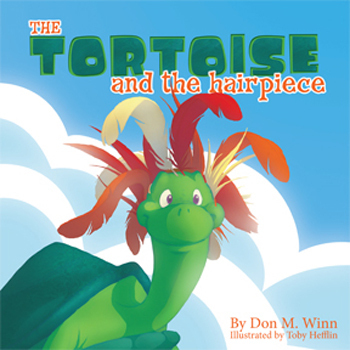
That’s why The Tortoise and the Hairpiece addresses this issue and includes questions at the end to help start conversations about self-image, even with very young children. The story and questions are a jumping-off point…each child is different and will have different concerns. So use the questions to help your children explore their thoughts and feelings on the subject of self-image…you may learn something new about them, and it will bring you closer together!
I’ve compiled some ideas to help parents help their kids develop a positive self-image about their appearance, and also a positive attitude about the way other people look. You can find a few more ideas in this article on the WebMD website too.
After meeting a new person, once you are alone with your child, point out positive, appropriate things you noticed about that person’s appearance. Mention the color of their eyes or their nice smile or anything else you appreciated. This will help children learn to look for the good aspects of other people’s appearances and not just to focus on less appreciated aspects. Training them to be able to see this way will help them learn to see themselves in the same way—appreciating the good things about their appearance.
Refrain from making negative comments about other people’s appearance in your children’s hearing.
When you see someone who looks happy and content, even a stranger in a crowd, if it is possible to do so in a discreet way, point that person out to your child. Draw their attention to the idea that a person looks attractive because they look happy. This could help children realize that attractiveness is not necessarily dependent on physical features.
If necessary, you could point out to your children that there’s a connection between practicing good hygiene and being considered attractive to other people.
Set a good example. Don’t let your children see you hating things about your own appearance. Show them through your words and actions and the comments you make about yourself that you are comfortable with who you are. Even if there are things about your appearance that you would like to change, let them see that these are not the most important things on your mind.
I’d love to hear your experiences. How have you helped your kids have a positive self-image in this world that is so concerned with appearances? What has worked for you? What have you learned about this as a parent? If you try any of the ideas above, what results have you seen?


June 16, 2016
Minimizing Summer Learning Loss
When I was a lad in elementary school, I couldn’t wait for summer vacation. As a dyslexic student, school was my greatest stressor, and that fact only made my longing for summer break more intense. During my carefree summer months, I rode my bike, climbed trees, played ball with friends, went exploring constantly, fished, caught frogs and locusts, and went on a family vacation. The last thing on my mind was reading books; I thought very little about school or the need to maintain what I’d struggled so hard to learn during the school season.

The truth is that all children, dyslexic or not, face an unintended consequence of the summer break from school—a “summer slide” or learning loss.
In 2011, the RAND Corporation published a study demonstrating how students in the United States lose an average of one month’s worth of learning in reading and math skills over the summer. Lower income students may lose up to two months of learning during the summer because they often don’t have as much access to a vacation or other educationally stimulating venues.
Let’s do the math: if the average school year lasts 8 months, and two months of education could be lost each year based on the summer slide statistic, potentially 25% of the school year’s value in critical areas like reading and mathematics simply vanishes—evaporating into thin air. (That is potentially 60 days of getting the kids up, getting them dressed and fed, dealing with homework drama, packing lunches and getting everyone out the door mostly on time…days you probably didn’t want to go through all that hassle, but you did anyway, because that’s what you do…It would be a shame for all that hard work to go to waste, right? Keep reading.)
The educational stakes for children are high, because these educational losses actually compound summer after summer. According to the study, 20% of third-graders in one state could not read at grade level. By the eighth grade, the number of students reading below grade level had increased to 33%. The accumulation of several years’ worth of summer reading loss greatly contributes to these statistics.
The good news is that small efforts to counteract the summer slide bring big returns. If a student reads as few as five books during the summer, it can prevent learning loss in reading skills. What can you do to help your children?
Read to your children or to a child you know. There is no better way to encourage reading than to read aloud with our young ones.
Encourage an interest in reading. This is more challenging for students with dyslexia or other learning differences. Talk with your kids and discover what their interests are. Ask a lot of “why” questions, and then find the answer together through reading—using online sources counts too. It’s still reading.
Use online tools like Goodreads to help your child feel a part of a group of readers. There, they can list books they’re going to read, comment and rate ones they’ve read, and feel a sense of accomplishment as they check books off their list.
Foster a sense of achievement. Colored stickers, gold stars, or other marks of completion can encourage kids to compete with themselves to read more and more.
Check your local library for summer reading programs and activities. Many libraries have lots of fun things available including author visits!

When kids get together over the summer, have each child take a turn talking briefly about things they have read. It doesn’t have to be a long, complicated discussion. Sixty to ninety seconds about each book is enough to stimulate an interest in reading among other kids in the community. This also gives the kids who have read books something to share that they can be proud of.
For children who really struggle with reading, or who cannot imagine reading ever being pleasurable, check your local library for audiobooks. Listening to books can be a real inroad into the heart of the challenged reader. The more they can develop a love of story, the more they will be inspired to discern their own learning and reading style and overcome their limitations. If they enjoy audiobooks, it can help dispel some negative emotions they may have previously associated with the idea of reading for pleasure.

This summer, as each family finds more fun reasons to read, I look forward to hearing from you. Let me know when you read your five books (or your first summer book, or your second…), including audiobooks. Which ones did you read? What did you like about them? Would you recommend them to others? Let’s make this a great summer! Happy Reading!
Other helpful blog articles:
Helping the at-risk reader by fostering the love of story
How heroes of self-reference can help struggling and dyslexic readers


June 1, 2016
Superhero: Then and Now
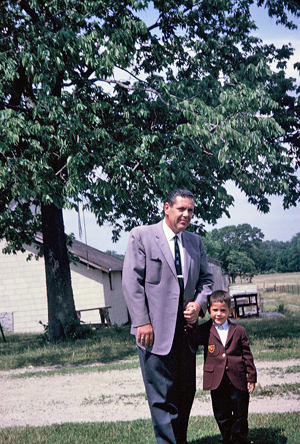 Who is your hero? Depending on your age and circumstance the answer could vary widely from a fictional story book character that becomes an imaginary hero to someone in real life that touched you personally in a meaningful way. In the introduction to my picture book Superhero, I stated that most of the time, the ordinary people doing ordinary things to help us are the most important people in our lives. And with this idea of a hero in mind, I can’t think of a greater hero than a loving parent.
Who is your hero? Depending on your age and circumstance the answer could vary widely from a fictional story book character that becomes an imaginary hero to someone in real life that touched you personally in a meaningful way. In the introduction to my picture book Superhero, I stated that most of the time, the ordinary people doing ordinary things to help us are the most important people in our lives. And with this idea of a hero in mind, I can’t think of a greater hero than a loving parent.
This is the time of year when many people show appreciation for their dad on a special day. Although my dad passed away many years ago, thoughts of him and what he meant to me stay with me year-round.
I have many great memories of my time with dad, but the most poignant ones are of the scary times when I needed reassurance. At those moments, my dad was my true hero. Whenever I was frightened or in over my head for any reason, I knew that I could call on my dad and he would be there for me.

I wrote Superhero in remembrance of my dad. He was always my superhero. In this book I pay tribute to my love for him, and hope to remind all parents that taking the time to reassure your children through their fears and insecurities will create a bond with them that lasts their whole lives.
So if you know a boy whose dad is his hero—or a girl who thinks the world of her dad—check out my book Superhero and share it with them.
Both books are available from either Amazon or BarnesandNoble.com.
“With this story, [children] will realize that anyone can be a hero, not just men in capes. By helping someone in need, you become a hero.” —Family Review Center


May 19, 2016
Shakespeare Reimagined: Interview with Alexander Parker
In this blog, I have addressed the benefits of teaching children persistence, dedication, and tenacity in an educational setting, especially for students who struggle to read. Today’s blog is especially relevant: what if there were a topic/writer who immediately conjured up an image of being difficult to understand? Or more difficult to read than other writers? Or one so old as to seem irrelevant? How engaged could you expect students to be in reading and understanding material like this? The answer: not much.
What comes to mind when you hear the name Shakespeare? For some, favorite passages trip off the tongue in pithy, poetic quotes, for others, (likely the majority) the feeling is little short of dread, especially if you’re a high school student facing ‘required’ reading. If you fall into the latter category, as I once did, then this blog interview is especially for you because now there is a better, more user-friendly way to experience Shakespeare!

I’d like to introduce you to Alexander Parker, CEO/Publisher of The New Book Press . Alexander has reimagined Shakespeare so that actors work before a white background right beside the written text to bring hard-to-understand works to life. Most students are required to have some Shakespeare, and many either find it completely intimidating (guilty as charged) or are stymied by its language, frequent references to obscure cultural issues of the past, and mythology.
However, the fact remains that these stories and characters are ageless and just as timely for modern generations as they were four hundred years ago. The stories just need a little user-interface lift for today’s generation, and that’s where Alexander Parker comes in. Alexander has kindly agreed to be interviewed for this blog about his process in making Shakespeare accessible to this generation.
Don: Hello Alexander, thank you so much for sharing your work with our readers! What was your first experience of reading Shakespeare like? Was it love at first read, or was it difficult in the beginning?
Alexander: Shakespeare did not come at all easily to me when I first read Romeo and Juliet at the age of 13. The writing seemed impenetrable, and the “genius” of Shakespeare’s style was totally lost on me. But it was required, and so I grimly slogged through the text, and learned by rote all the things that are taught to this day—the powerful imagery, the difference between Romeo’s language before and after he meets Juliet, the details of iambic pentameter, and so on. We also were allowed to watch (as a great treat) Zeffirelli’s 1968 film of the play (which in my view stands the test of time very well!) By the way, we watched it crowded around a 15” TV, which was hooked up to a VHS tape machine!

Don: How did the WordPlay Shakespeare Series come about?
Alexander: While working at Harvard University, I became interested in the history and evolution of books, and the way various things that we take for granted in books—page numbers, indexes, embedded graphics and images, different book sizes—even paper, ink, and bound-at-the-spine pages—actually evolved over many hundreds of years. I began to wonder how books might evolve in the future, and with the emergence of devices like the Kindle and the iPad, I felt this was a great time to experiment with new forms of books, specifically, ones that contained movement and sound in the pages. The question was what to try, and that’s when I had the idea to try and put a performance of a play “on the page,” next to the text. Because Shakespeare is still required reading, and the text can be difficult, I decided to start with his plays.
Don: How does bringing text and film together on the same page help struggling readers?
Alexander: Most Shakespeare teachers will tell you that reading Shakespeare is a slightly unnatural activity, because Shakespeare never intended for his plays to be read. They were written to be seen heard, and experienced. This goes to the heart of why Shakespeare is so hard to understand—we are reading 450-year-old English, and we are reading it without any of the visual cues and clues that one would normally have when watching a performance. By that, I mean things like intonation, inflection, silences, glances, body languages, direction of speech, entrances and exits, and all manner of movements on the stage which would immediately clarify much of the text. At the end of the day, when you read a Shakespeare play, you are reading a script, and since not all of us are professional actors, what we’re reading is really the “code” for the play. As an analogy, imagine claiming that reading the recipe for a dish was as good as eating the dish itself! Or that, for most of us, reading the sheet music would allow us to appreciate the music. Like the text of plays, recipes and sheet music are just instructions.

Don: What is something about Shakespeare that most people would be surprised to learn?
Alexander: A lot of energy has been spent pursuing various sensational claims about William Shakespeare—for instance that Shakespeare “wasn’t Shakespeare” (that it was in fact a pen name for the Earl of Oxford), or that he was a secret Catholic (a dangerous thing to be in Protestant Elizabethan England), and so on. Those are all enjoyable things to speculate about. But I think some of the subtler things are also more interesting. We’ve been lucky, when making the WordPlay eBook series, to consult with Yale University Professor David Scott Kastan, and a couple of things David mentioned have stuck with me. He said that Shakespeare was of course an extraordinarily good writer, but he was also, in all likelihood, an incredibly good listener. He seemed to be a magnet for the telling phrase or word, and when people say he invented some 1,300 new words it’s highly unlikely he invented them all—but he did hear many of them, and committed them to paper for the first time. The other thing that might surprise people, is that Shakespeare was probably not the most popular, or even the second most popular playwright of his time, that honor probably going to the writing team of Beaumont & Fletcher, and Ben Johnson, respectively.
Don: In your estimation, what seems to make Shakespeare most inaccessible to readers?
Alexander: I think it’s a combination of two or three things, two of which I have already mentioned; the 450-year-old language, which though tantalizingly similar to what we use today, is also sufficiently different that it can hang us up, and often breaks the flow that we are used to when reading text; and the fact that in reading the text, we are not able to see all the context that actors would add to make clear what is going on.
Two others that come to mind are first, cultural references that an audience in the 17th Century would have immediately understood, but that we in the 21st Century would have no clue about, and second, the fact that some words that mean one thing to us today, often meant something different back then. For instance, the verb “to let,” today means “to permit, or allow.” However, back in the 17th Century, it meant almost the exact opposite, namely “to hinder, or get in the way of.” These sorts of differences, though seemingly no big deal alone, when added together, make for tough reading, and significant barriers to understanding.
Don: Do you offer a modern translation of the plays?
Alexander: Yes, we do—in fact, starting in the fall of 2016, we will offer at least four different translations of each play, and teachers will be able to select which one works best for themselves and their students—a version which is “lightly simplified” (that is, we change as few words as possible, which works best for stronger students), a version which is more heavily simplified, to make even clearer what is meant, a modern Spanish translation, and then, in a slightly different approach, a version which will have a page by page summary of the text, so that students can get a page by page gist of what the original is saying.
Don: Is there a synopsis of each scene available?
Alexander: Yes—in fact it was the popularity of the scene by scene synopses that led us to expand into doing the page by page summaries. At some level, it is less controversial than trying to mimic and simplify the language, and some students react very well to this sort of support.

Don: What sort of feedback are you receiving from early adopters of your technology?
Alexander: Responses from teachers and students alike have been very favorable. In a way, what I like more though, is the criticisms (well, sort of like! It’s the criticisms that help us improve the edition every year). On the positive side, we hear all the things we hoped to hear— WordPlay eBooks are easier to understand, more enjoyable to read and experience, leading to more detailed and interesting discussions about the themes, motifs, grammatical structures and vocabulary, and so on. Of the questions we receive, the interesting ones are things like “why do the actors wear modern clothes?” and “why is there so little scenery,” and “why do all the actors play at least two roles?” All these questions are legitimate, and also offer great teachable moments, to discuss staging, directing, interpretation and so on.
On the technology front, what we have learned is that a school does not have to have a 1:1 program, or even that many computers around, since—and we were really blown away by this detail—in a study performed by the University of Houston with one of the districts we were working with, we discovered that substantial numbers of students were using their own smart phones to read and view the plays. Just amazing, and incredibly exciting too!
Don: What’s next for The New Book Press?
Alexander: Well, right now we’re just working with schools, teachers, and students to get it into their curricula, and improve the pedagogical techniques around these eBooks. Once we have established a larger base, we will start production on our next play—Julius Caesar.
Don: Where can readers find out more?
Alexander: We are on the web at http://thenewbookpress.com/TNBP/Home.html and the best way to stay in touch with what’s coming next is to subscribe to our newsletter/mailing list, which you can find on our website. If you are a teacher and want a free demonstration license, just email us at info@thenewbookpress.com, and we’ll set you up with one of the plays.
For people who have iPads or Macs, the eBooks are also in “iBook” format. They run $20.00 each, which is more than the streaming version for schools, but some folks may be interested in purchasing.
Here are the links for the three:
Macbeth
A Midsummer Might’s Dream
Romeo and Juliet
Don: Thank you so much for spending some time with our readers. I am so excited about this project, and what it will mean for readers everywhere!
Whether you are a teacher, student, or an adult who would love to be able to enjoy Shakespeare fully, please check out this wonderful, enriching educational tool.


May 4, 2016
The Elephant in the Room

Say the words, “mental illness” in conversation, and the whole room collectively stops talking and holds its breath. Few topics cause more unease, nervous laughter, or feelings of flight response. It’s a rare soul who sticks around for a curious, collaborative exploration of the topic. No, instead, we are more inclined to avoid any such discussion and marginalize those who suffer from any form of mental illness. Because May is Mental Health Awareness Month, and in honor of my mother who suffered from a mental illness, I offer the following.
Society at large seems to turn a blind eye to the prejudice which is shown toward fellow humans with mental illness. Mental illness is confusing, troubling, and unsettling: those who suffer from it may experience times when they don’t talk, act, or react in ways that can be easily interpreted or understood by others. Let’s face it: some episodes can be downright frightening. And those actions can spark reactions in those around them. Emotion is contagious, and when those in our circle are anxious, angry, paranoid, depressed, despondent, confused, worried, suicidal, or antisocial, we can pick up on some of that discomfort ourselves. No one likes discomfort. So, all too often, we pull away—it’s rather like the childhood injunction not to touch a hot stove, lest we get burned. If we feel like we’ve been “burned” by the unusual behaviors of someone we know, we are less inclined to include them in our lives. Therein lies the problem: the human tendency to stigmatize what we don’t understand.
Stig’ma: (archaic) a mark or a brand burned into the skin of a criminal or slave

Stigmatization marginalizes humans. It de-personalizes them. It judges them as unworthy and loudly proclaims: Stay Away. All other forms of illness are things that one has: diabetes, cancer, hypertension. But mental illnesses are often (and very incorrectly) described as what one is: bipolar, schizophrenic, and more.
On the other hand, some people’s responses to the idea of mental illness can swing too far in the other direction, enforcing the casual view that mental illness is just one more kind of illness a person has to make adjustments to deal with. Frederick Godwin, MD, former Director of the National Institute of Mental Health makes this statement: “When we’re dealing with the brain, we’re dealing with that interface between an illness and a person. So when we trivialize mental illness by saying it’s no different than high blood pressure, a lot of people who are pretty savvy say, “Wait a minute, this is a little different from high blood pressure.” That phrase, “the interface between illness and a person” is key because it begins to describe the incredible complexity and sensitivity needed to support such sufferers.
One of my all-time favorite scientists, the wise, humane, and curious Oliver Sacks, MD, makes this contribution to the discussion: “I don’t like that term mental illness. I think any, any difference, physical or mental, from the norm may be seen as frightening or threatening. But they’re as human as you are, as sensitive as you are, they have all the desires and dreams which you have, they have the abilities which you have, but may live to some extent from a different center. But allow that, and honor it. In some sense there should be realization that it’s ok to have mental illness (so called), and that a lot of the most important things in civilization have been brought about by people with ‘mental illness.’“
Ask yourself, “How would I feel if I were the one everyone looked away from?” Curiosity is a bridge to compassion. When we see a workmate, schoolmate, family member display behaviors that fall outside societal norms, be curious rather than leaping to judgement and avoidance. Ask yourself, “What must he/she have been feeling to be induced to act that way?” Please don’t think I’m recommending unsafe behaviors; taking someone who’s having a psychotic breakdown out for pizza isn’t what I’m talking about here. Rather, it’s time for all of us to become more aware of the isolation the mentally ill endure, and give some thought to how we can include them in our lives. It’s time to brainstorm ways to offer kind, compassionate support, and learn to recognize the incredible gifts and talents offered by humans dealing with mental illness.
Looking out for one another is a good place to start.

NAMI, the National Alliance on Mental Illness offers this helpful list of some warning signs that may indicate a mental illness:
Excessive worrying or fear
Feeling excessively sad or low
Confused thinking or problems concentrating and learning
Extreme mood changes, including uncontrollable “highs” or feelings of euphoria
Prolonged or strong feelings of irritability or anger
Avoiding friends and social activities
Difficulties understanding or relating to other people
Changes in sleeping habits or feeling tired and low energy
Changes in eating habits such as increased hunger or lack of appetite
Difficulty perceiving reality (delusions or hallucinations, in which a person experiences and senses things that don’t exist in objective reality)
Inability to perceive changes in one’s own feelings, behavior or personality (“lack of insight” or anosognosia)
Abuse of substances like alcohol or drugs
Multiple physical ailments without obvious causes (such as headaches, stomach aches, vague and ongoing “aches and pains”)
Thinking about suicide
Inability to carry out daily activities or handle daily problems and stress
An intense fear of weight gain or concern with appearance (mostly in adolescents)
Mental health conditions can also begin to develop in young children. Because they’re still learning how to identify and talk about thoughts and emotions, their most obvious symptoms are behavioral. Symptoms in children may include:
Changes in school performance
Excessive worry or anxiety, for instance fighting to avoid bed or school
Hyperactive behavior
Frequent nightmares
Frequent disobedience or aggression
Frequent temper tantrums
See more at: NAMI.org
In closing, please check out these two helpful websites. Both strive to eliminate the bias and stigmatization I have discussed here today, and offer lots of valuable tips, videos, and resources for sufferers and their friends and loved ones.
http://bringchange2mind.org/learn/what-is-stigma/
http://thehotstoveproject.org/mission/


April 21, 2016
Dyslexia: the Writing is on the Wall—From Birth
 Most of us with dyslexia were diagnosed after several failure-filled, white-knuckled, angst-ridden years in school, or even as late as adulthood. Diagnosis at any age is a good thing: it allows us to finally understand our experience and educate ourselves on coping strategies. But it looks as if future generations may not have to suffer the extensive stress, crippling academic lag, and self-esteem issues we did. Boston Children’s Hospital Laboratory of Cognitive Science is out to change things.
Most of us with dyslexia were diagnosed after several failure-filled, white-knuckled, angst-ridden years in school, or even as late as adulthood. Diagnosis at any age is a good thing: it allows us to finally understand our experience and educate ourselves on coping strategies. But it looks as if future generations may not have to suffer the extensive stress, crippling academic lag, and self-esteem issues we did. Boston Children’s Hospital Laboratory of Cognitive Science is out to change things.
Nadine Gaab, PhD, and lab members Nicolas Langer, PhD, and Barbara Peysakhovich have found that the signs of dyslexia are present as early as infancy. In 2012, the Gaab Lab showed that pre-readers with a family history of dyslexia (average age, 5½) have differences in the left hemisphere of their brains on magnetic resonance image (MRI).
“The first day they step in a kindergarten classroom, they are already less well equipped to learn to read,” Gaab says.
Some researchers postulate that kids had that difference because of dyslexic parents, and poor learning environments at home. But what if the brain difference was caused by nature, not nurture? To get to the bottom of that question, Gaab and her team performed MRI scans on 14 infants from dyslexic family histories, and 18 same-age infants without dyslexic family history. All the infants were only 18 months old.
The MRI scan utilized an advanced technique called diffusion tensor imaging (DTI). DTI measures the flow of water molecules along the brain’s fiber tracts, and gives a good indication of fiber structure, orientation, and its impact on how well information is flowing in the brain.

The arcuate fasciculus in a child with a family history of dyslexia (L) versus no family history (R), as seen on DTI (attribution footnoted)
The findings, published in the journal Cerebral Cortex, discovered alterations in a particular structure called the arcuate fasciculus, a bundle of fibers that connect the posterior cortex, which is involved in mapping sounds and word/letter recognition, with the frontal cortex, which integrates and comprehends this information.

Detailed segmentation of the images revealed that fibers in certain areas of the arcuate fasciculus, shown above as red bands, were consistently less organized. (Attribution footnoted)
Historically, people who have suffered damage to the arcuate fasciculus have problems with expressive and receptive language and with phonological processing — the ability to manipulate and understand the sounds of a language, a critical part of learning to read. In infants with familial dyslexia, inherited genes may interfere with the development of the arcuate fasciculus before birth, says Gaab, impairing its structural integrity.
“The street could be full of potholes, or it could be the street is narrow or has a really crappy surface, or there might be a lot of intersections where you have to stop,” she says, describing how an individual’s processing could be impacted by these structural changes.
“We hope this study will help show that kids should get interventions before kindergarten,” says Gaab. “We’re not saying you should scan every kindergartener, but if you have a strong family history, you could potentially have a five-minute DTI scan to see if you are at risk.”
As I have often discussed in this venue, the earlier the intervention, the better. Intervention from toddlerhood may have never seemed possible in the past, but these important findings offer parents the opportunity to get their kids off to the best possible educational start in life. It truly is a good time to be alive.
Sources and Image Sources:
http://m.cercor.oxfordjournals.org/content/early/2015/12/04/cercor.bhv281
http://www.tandfonline.com/doi/abs/10.1207%2FSLDRP1501_6
http://vector.childrenshospital.org/2015/12/for-dyslexia-writing-is-often-on-the-wall-from-birth/


April 7, 2016
Getting a Head Start on Fostering Imagination
When Space Cop Zack, Protector of the Galaxy, was released in the fall of 2013, I mentioned at that time that my book is about the “beta version” of imagination—childhood fantasies that help kids develop their imaginations into powerful tools that can serve them well throughout their life.
And of course imagination has more benefits than helping them to become better problem solvers. It has important psychological and psychosocial benefits, especially for developing children. It can help kids learn to think symbolically, an essential skill in the world we live in today. Thinking symbolically is the first step on the road to critical thinking.
 I’m thrilled to announced that Space Cop Zack was recently named a UK Wishing Shelf Book Award Gold Medal Winner! Wishing Shelf Awards are distinctive: all the voters are readers in 8 primary and second schools in the UK. When your book gets special notice from kids who have hundreds of other submissions to consider, it feels great! The Wishing Shelf Book Award is just the latest mark of recognition given to Space Cop Zack.
I’m thrilled to announced that Space Cop Zack was recently named a UK Wishing Shelf Book Award Gold Medal Winner! Wishing Shelf Awards are distinctive: all the voters are readers in 8 primary and second schools in the UK. When your book gets special notice from kids who have hundreds of other submissions to consider, it feels great! The Wishing Shelf Book Award is just the latest mark of recognition given to Space Cop Zack.
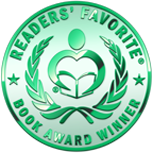 Space Cop Zack, Protector of the Galaxy received a five-star review and won a Readers’ Favorite Book Award.
Space Cop Zack, Protector of the Galaxy received a five-star review and won a Readers’ Favorite Book Award.
“The author does a fantastic job of capturing a little boy’s imagination…If you are looking for a funny, fun, and entertaining book for your child’s library…pick up a copy and see for yourself what a great book this is.” —Readers’ Favorite
 Space Cop Zack, Protector of the Galaxy has been named among the best in family-friendly media, products and services by the Mom’s Choice Awards®
Space Cop Zack, Protector of the Galaxy has been named among the best in family-friendly media, products and services by the Mom’s Choice Awards®
Space Cop Zack, Protector of the Galaxy was given the Family Review Center Seal of Approval for its “pages and pages of imagination extravaganza!”
Below is a preview of Space Cop Zack, Protector of the Galaxy, joined by his faithful robot sidekick GARG.
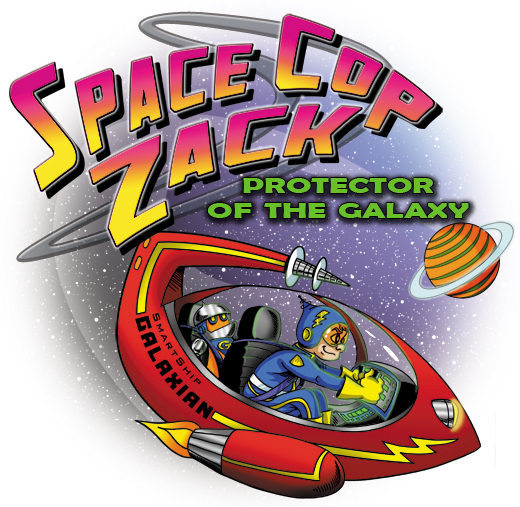
Space Cop Zack is a celebration of the power of the imagination. Travel through the galaxy with intrepid Space Cop Zack and his faithful robot sidekick GARG. Together they take on the pursuit of the terrible Dr. Dogbreath, chasing him through the asteroids, oceans, and unusual plant life of Zack’s galaxy. Zack and GARG brave bad smells, squishy slime, giant ocean monsters and even motion sickness.

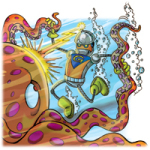
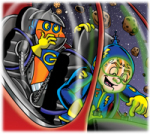

Will they finally capture Dr. Dogbreath, or will he escape their grasp? That will all depend on where your imagination takes you. Who knew 15 pages could hold so much excitement?

Check out this gorgeous, high-quality color book in softcover, hardcover, or eBook formats. Available from Amazon, Amazon UK, Amazon Canada, Barnes and Noble, and other online booksellers.
Don’t miss out on any new releases by Don Winn. Sign up for my Don Winn’s Cardboard Box Adventures newsletter. It’s only published every other month, so it will never overload your inbox!. And you can follow my blog via email using the button below. Come join in the discussion! I love hearing from readers, parents, and educators.


March 31, 2016
Sir Kaye at Sherwood Forest Faire: A Trip Back in Time
One of the ideas that captivates people most is that of traveling back in time and being able to experience life in the Middle Ages. Although we can’t literally go back in time, we can come closer than you might think. I got a real feel for life in the Middle Ages through a lovely renaissance festival, the Sherwood Forest Faire near McDade, Texas. Since my Sir Kaye Series of middle reader books takes place in medieval times, I was invited to participate at the event with an author table and daily presentations about life in the Middle Ages. The presentation, The Medieval World of Sir Kaye, is one of several that I give in schools.

The Sherwood Forest Faire is a fun, family-oriented event that allows you to dress in the character of your choice for the time period and to transport yourself back to the year 1195. What will you find?
A cannon fires, and the gates open. As you proceed through the gated entrance, you are greeted by:
ladies of the court,

the Sheriff and his men,

archers,

and too many others to picture them all: knights on the jousting field, jugglers, fools, kings and queens, pirates, Vikings, and more.

Wending your way up and down the gentle peaks and valleys of the extensive shade-dappled grounds, you feel the embrace of the towering oaks and pines standing guard over the new world you have entered. Their shelter, and the warmth and genuineness of the caring performers welcoming you into their enclave, let you know that you have a new home amongst them.

Entertainment and learning opportunities go hand in hand: blacksmiths, jewelers, candle makers, potters, leatherworkers, and chain mail crafters are just a few of the skilled artisans who share their wealth of knowledge with all who care to learn.
A petting zoo, complete with camel rides, delights young and old alike.

A favorite of mine, for reasons obvious to my loyal blog readers, was the falconry show presented by Sky Kings Falconry. Falconry was a huge part of life in medieval times, and the show represented the sport beautifully with inspiring, well-trained birds of prey.

When you enter the falconry show, you’ll find perches built behind the audience seating. As each of the birds come out in turn, they interact with the trainer on stage and then make low-flying passes over the audience as they glide from perch to perch, snagging their beloved treats. There was a lot of good-natured ducking by audience members as the birds flew overhead, and shrieks of excitement from being able to get up close to these magnificent birds and raptors.

It was my first time to see a Kookaburra, the largest member of the Kingfisher family, and he was a delightful surprise. With the bird perched on the hand, his trainer held his face close and made sounds to the bird, who replied with a volley of cackling noises of the sort you’d expect to hear from a troupe of monkeys! They held a duet of sorts, trainer, and bird clicking and cackling to each other. I could see the real affinity the two had for each other. Here are a few action shots to give you a feel for that experience and the other stars of the show, including an Owl, Kestrel, Falcon, and even a Vulture!

There are so many other wonderful things to see, do, and enjoy at the Faire, but space doesn’t permit me to share them all here today. But my take-away from Sherwood Forest Faire is that if you are the parent of a reluctant or struggling reader, bringing them to a place filled with living history can only help encourage them to search for more enchantment in the form of great stories.
A special thanks goes to Entertainment Director Zane Baker, aka Autouloucous Crookfinger (pictured below), for his attention to detail at this wonderful event, for arranging my participation, and his generous hospitality.

Be sure to check out the Sherwood Forest Faire Summer Camp Programs!


March 17, 2016
Your Favorite Childhood Stories: Then and Now
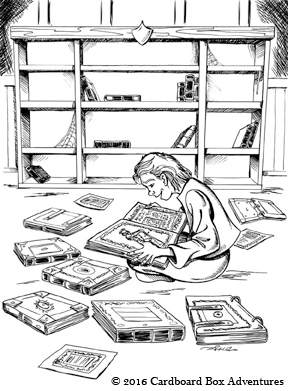 What is your favorite childhood story? Why is it your favorite? I never tire of hearing the answers to these questions; each of us has our own story to tell, and the answers to questions such as these always have an interesting “because” appended to them. We may find that some childhood memories become hazy as the years pass, but folks can always remember their favorite books. Beloved books stay with us forever.
What is your favorite childhood story? Why is it your favorite? I never tire of hearing the answers to these questions; each of us has our own story to tell, and the answers to questions such as these always have an interesting “because” appended to them. We may find that some childhood memories become hazy as the years pass, but folks can always remember their favorite books. Beloved books stay with us forever.
I’m often asked what inspires me to write kids’ books. There are many reasons. One is related to the discussion above: I want to write stories that kids will remember fondly, stories so engaging that even the most reluctant reader will persevere. Another is the fact that I know what a tough, special job parenting is.
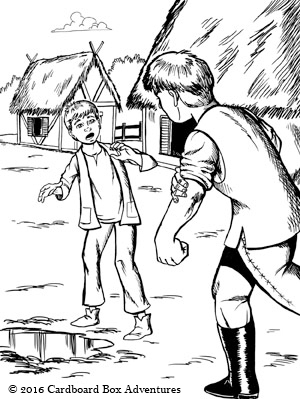 The enormity of what parents need to teach children before sending them out into the world can be staggering to contemplate. Lessons about life can be hard to talk about, and even harder to teach in a way that reaches a child’s heart. How can parents make the most of their time with their children, and make sure children are well-equipped to face the challenges of life on their own?
The enormity of what parents need to teach children before sending them out into the world can be staggering to contemplate. Lessons about life can be hard to talk about, and even harder to teach in a way that reaches a child’s heart. How can parents make the most of their time with their children, and make sure children are well-equipped to face the challenges of life on their own?
In a word, stories. When parents read stories with their children, it allows them to spend time with their kids enjoying fun tales of humor and adventure, and it presents parents with the opportunity to teach vital life lessons at the same time. Reading great stories together optimizes the limited time parents have with their kids before they’re grown and gone. Teaching with stories allows parents to use beloved, relatable characters to prepare their children for future experiences.
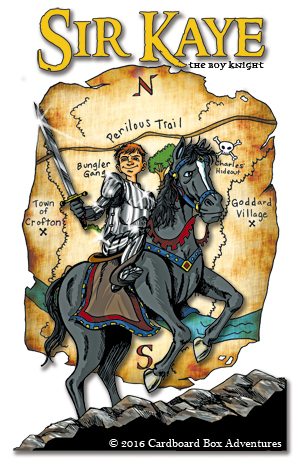 When considering what types of stories I wanted to write, I thought back to my own childhood. As a boy, I was inspired by strong characters such as Horatio Hornblower by C.S. Forester. When Horatio faced overwhelming odds, or even failure, he always strove to make good choices. What appealed to me the most? Horatio had a strong sense of personal identity, and never lost sight of the fact that living his best life meant being true to himself and the values he held dear.
When considering what types of stories I wanted to write, I thought back to my own childhood. As a boy, I was inspired by strong characters such as Horatio Hornblower by C.S. Forester. When Horatio faced overwhelming odds, or even failure, he always strove to make good choices. What appealed to me the most? Horatio had a strong sense of personal identity, and never lost sight of the fact that living his best life meant being true to himself and the values he held dear.
My favorite childhood stories featured adventure, self-discovery, friendship, coming-of-age, and facing one’s fears. I loved these stories because they depicted many of the same situations and feelings I struggled with, yet their characters discovered their strengths and made a difference in their world. Little did I know then that I had discovered what is called a ‘hero of self-reference’, or a character I could truly identify with because they faced the same things I did. My heroes of self-reference even helped me identify and find the words to express my own feelings.
Today’s “heroes” mostly embody a different sort of ideal: one where the primary coping skills for living involve superpowers or even magic. While millions are entertained by such stories, themes such as these do little to prepare kids to cope realistically with real life events or feelings like bullying, learning challenges, frustration, sadness, fear, or the need for stick-to-itiveness. Children need to learn how to cope with these matters in real-world ways, because they will face them in the real world.
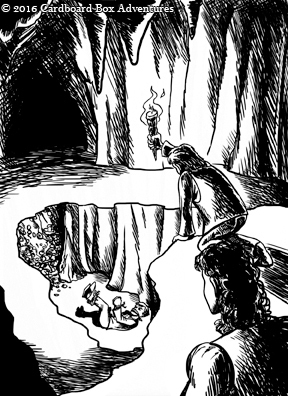 I want the Sir Kaye, the Boy Knight series of middle-reader novels for children to embody the same values as my favorite childhood stories and characters. The Sir Kaye books, starring the young knight Sir Kaye, are fun, exciting adventures that appeal to even the most reluctant reader. Kaye’s beloved but absent father is his inspiration, and he strives to meet challenges with the values his chivalrous father taught him. His best pal, Reggie, who is dyslexic, also discovers his own strengths and weaknesses, and surprises himself by his ability to make a difference. This series is unique because it features characters learning to do the right thing without magic or superpowers. These young heroes deal with internal questions and uncertainty as they work through the events they face, and each one finds his own way. The books are fun and enjoyed by any reader, but are particular favorites of kids who need heroes of self-reference for dyslexia, learning challenges, absentee parents, those who are targets of bullying, or kids with low self-esteem.
I want the Sir Kaye, the Boy Knight series of middle-reader novels for children to embody the same values as my favorite childhood stories and characters. The Sir Kaye books, starring the young knight Sir Kaye, are fun, exciting adventures that appeal to even the most reluctant reader. Kaye’s beloved but absent father is his inspiration, and he strives to meet challenges with the values his chivalrous father taught him. His best pal, Reggie, who is dyslexic, also discovers his own strengths and weaknesses, and surprises himself by his ability to make a difference. This series is unique because it features characters learning to do the right thing without magic or superpowers. These young heroes deal with internal questions and uncertainty as they work through the events they face, and each one finds his own way. The books are fun and enjoyed by any reader, but are particular favorites of kids who need heroes of self-reference for dyslexia, learning challenges, absentee parents, those who are targets of bullying, or kids with low self-esteem.
What can you look for in the Sir Kaye books?
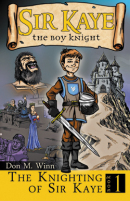 In book on
In book on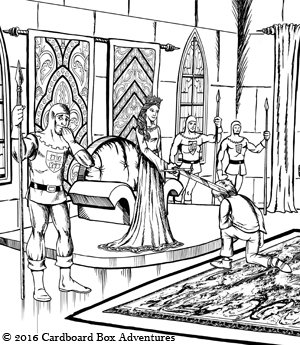 e, The Knighting of Sir Kaye, Kaye is an ordinary boy who likes exploring and dreams of being a legendary knight like his father. But good knights are hard to find in Knox since the king died. When the new queen knights Kaye for doing a brave deed to help another person, he gets his wish a lot sooner than he expected. Being a knight is a dream come true for Kaye…but he’s got a lot to live up to. Can he hold his own against all the other knights who hate him? Can he outwit the terrible Sir Melchor and defeat him in the deeds-at-arms competition that all knights in the kingdom must participate in? Can he help the queen save her kingdom…even a little bit?
e, The Knighting of Sir Kaye, Kaye is an ordinary boy who likes exploring and dreams of being a legendary knight like his father. But good knights are hard to find in Knox since the king died. When the new queen knights Kaye for doing a brave deed to help another person, he gets his wish a lot sooner than he expected. Being a knight is a dream come true for Kaye…but he’s got a lot to live up to. Can he hold his own against all the other knights who hate him? Can he outwit the terrible Sir Melchor and defeat him in the deeds-at-arms competition that all knights in the kingdom must participate in? Can he help the queen save her kingdom…even a little bit?
The Knighting of Sir Kaye Awards: IndieReader Discovery Award, Moms’ Choice Award Gold, Moonbeam Children’s Book Award Silver, Wishing Shelf Award Silver, Voyager Marble Award.
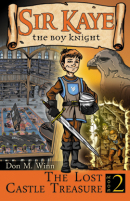 The adventure continues with book two in the Sir Kaye series, The Lost Castle Treasure. The treasure house of Knox castle is empty! Now conspiracy and war threaten the kingdom while mysterious noises and unexplained events fill the castle. As best friends Kaye, Reggie, and Beau search for
The adventure continues with book two in the Sir Kaye series, The Lost Castle Treasure. The treasure house of Knox castle is empty! Now conspiracy and war threaten the kingdom while mysterious noises and unexplained events fill the castle. As best friends Kaye, Reggie, and Beau search for 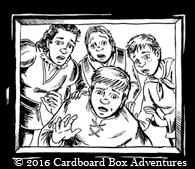 the missing treasure, jealous knights plot to get rid of Kaye for good. Can Kaye find the treasure in time to save the kingdom? Or will he risk losing his knighthood forever? Join Kaye, Reggie, and Beau as they search for hidden clues, secret passages, a lost castle treasure, and their place in the world in this fast-paced adventure.
the missing treasure, jealous knights plot to get rid of Kaye for good. Can Kaye find the treasure in time to save the kingdom? Or will he risk losing his knighthood forever? Join Kaye, Reggie, and Beau as they search for hidden clues, secret passages, a lost castle treasure, and their place in the world in this fast-paced adventure.
The Lost Castle Treasure Awards: Mom’s Choice Award Gold, Wishing Shelf Award Finalist, Readers’ Favorite Award Finalist, IndieFab Book of the Year Award Finalist
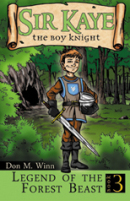 Legend of the Forest Beast is the third book in the Sir Kaye series. Kaye’s tutor is missing! Kaye, Reggie, and Beau set out to find him. Vanishing sheep, rumors of a mysterious beast, and one very determined girl make this an adventure of a lifetime. (To be released in 2016).
Legend of the Forest Beast is the third book in the Sir Kaye series. Kaye’s tutor is missing! Kaye, Reggie, and Beau set out to find him. Vanishing sheep, rumors of a mysterious beast, and one very determined girl make this an adventure of a lifetime. (To be released in 2016).
“A fun, exciting adventure…Sir Kaye is a fantastic role model for kids.” —Wishing Shelf Awards
“Fortitude, good will, and friendship triumph in this enjoyable story.” —Publishers Weekly
Every family is busy these days, and quality time with children needs to count on multiple levels: not just for fun and nurturing, but also as an opportunity to find out what kids are thinking and feeling as you explore stories and situations together. Reading great books together and talking about them can give your children direction they will remember for a lifetime. Help them develop a strong sense of self as you prepare them for their best life.
Please leave a comment and share your favorite childhood stories. What books hold a special place in your heart and why?
Learn more about the Sir Kaye series and where to find the books.





